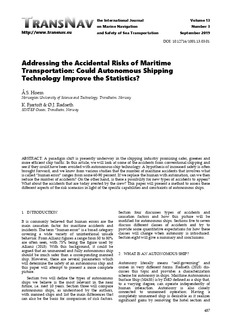Addressing the Accidental Risks of Maritime Transportation: Could Autonomous Shipping Technology Improve the Statistics?
Journal article, Peer reviewed
Published version
Permanent lenke
http://hdl.handle.net/11250/2625182Utgivelsesdato
2019-09Metadata
Vis full innførselSamlinger
- Publikasjoner fra CRIStin - SINTEF Ocean [1369]
- SINTEF Ocean [1443]
Originalversjon
10.12716/1001.13.03.01Sammendrag
A paradigm shift is presently underway in the shipping industry promising safer, greener and more efficient ship traffic. In this article, we will look at some of the accidents from conventional shipping and see if they could have been avoided with autonomous ship technology. A hypothesis of increased safety is often brought forward, and we know from various studies that the number of maritime accidents that involves what is called “human error” ranges from some 60-90 percent. If we replace the human with automation, can we then reduce the number of accidents? On the other hand, is there a possibility for new types of accidents to appear? What about the accidents that are today averted by the crew? This paper will present a method to assess these different aspects of the risk scenarios in light of the specific capabilities and constraints of autonomous ships.
Utgiver
Faculty of Navigation, Gdynia Maritime University, PolandTidsskrift
TransNav, International Journal on Marine Navigation and Safety of Sea Transportation
Med mindre annet er angitt, så er denne innførselen lisensiert som Attribution-NonCommercial-NoDerivatives 4.0 Internasjonal
Beslektede innførsler
Viser innførsler beslektet ved tittel, forfatter og emneord.
-
Additive Manufacturing of Spare Parts in the Maritime Industry: Knowledge Gaps for Developing a Norwegian AM-Based Business Ecosystem for Maritime Spare Parts
Halvorsen, Trond; Lamvik, Gunnar Martin (Chapter; Peer reviewed, 2021)Additive Manufacturing (AM), also known as industrial 3D printing, is a high skill technology that can improve the safety level in the maritime industry, reduce costs for the actors and lead to environmental improvement ... -
Integrating IEC and ISO information models into the S-100 Common Maritime Data Structure
Rødseth, Ørnulf Jan (Others, 2016-03-14)The implementation of new e-navigation services will be heavily dependent on the Common Maritime Data Structure (CMDS) based on the IHO S-100 framework. Much work is already being committed to this. However, the development ... -
Sulphur Abatement Globally in Maritime Shipping
Lindstad, Elizabeth; Rehn, Carl Fredrik; Eskeland, Gunnar (Journal article; Peer reviewed, 2017)In 2016, the International Maritime Organization (IMO) decided on global regulations to reduce sulphur emissions to air from maritime shipping starting 2020. The regulation implies that ships can continue to use residual ...

